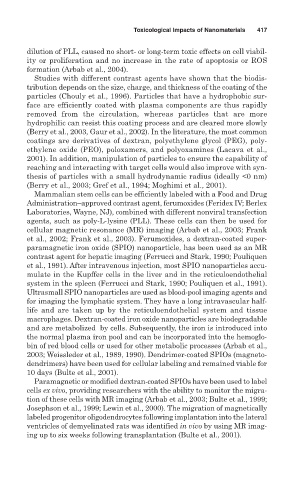Page 437 - Environmental Nanotechnology Applications and Impacts of Nanomaterials
P. 437
Toxicological Impacts of Nanomaterials 417
dilution of PLL, caused no short- or long-term toxic effects on cell viabil-
ity or proliferation and no increase in the rate of apoptosis or ROS
formation (Arbab et al., 2004).
Studies with different contrast agents have shown that the biodis-
tribution depends on the size, charge, and thickness of the coating of the
particles (Chouly et al., 1996). Particles that have a hydrophobic sur-
face are efficiently coated with plasma components are thus rapidly
removed from the circulation, whereas particles that are more
hydrophilic can resist this coating process and are cleared more slowly
(Berry et al., 2003, Gaur et al., 2002). In the literature, the most common
coatings are derivatives of dextran, polyethylene glycol (PEG), poly-
ethylene oxide (PEO), poloxamers, and polyoxamines (Lacava et al.,
2001). In addition, manipulation of particles to ensure the capability of
reaching and interacting with target cells would also improve with syn-
thesis of particles with a small hydrodynamic radius (ideally <0 nm)
(Berry et al., 2003; Gref et al., 1994; Moghimi et al., 2001).
Mammalian stem cells can be efficiently labeled with a Food and Drug
Administration–approved contrast agent, ferumoxides (Feridex IV; Berlex
Laboratories, Wayne, NJ), combined with different nonviral transfection
agents, such as poly-L-lysine (PLL). These cells can then be used for
cellular magnetic resonance (MR) imaging (Arbab et al., 2003; Frank
et al., 2002; Frank et al., 2003). Ferumoxides, a dextran-coated super-
paramagnetic iron oxide (SPIO) nanoparticle, has been used as an MR
contrast agent for hepatic imaging (Ferrucci and Stark, 1990; Pouliquen
et al., 1991). After intravenous injection, most SPIO nanoparticles accu-
mulate in the Kupffer cells in the liver and in the reticuloendothelial
system in the spleen (Ferrucci and Stark, 1990; Pouliquen et al., 1991).
Ultrasmall SPIO nanoparticles are used as blood-pool imaging agents and
for imaging the lymphatic system. They have a long intravascular half-
life and are taken up by the reticuloendothelial system and tissue
macrophages. Dextran-coated iron oxide nanoparticles are biodegradable
and are metabolized by cells. Subsequently, the iron is introduced into
the normal plasma iron pool and can be incorporated into the hemoglo-
bin of red blood cells or used for other metabolic processes (Arbab et al.,
2003; Weissleder et al., 1989, 1990). Dendrimer-coated SPIOs (magneto-
dendrimers) have been used for cellular labeling and remained viable for
10 days (Bulte et al., 2001).
Paramagnetic or modified dextran-coated SPIOs have been used to label
cells ex vivo, providing researchers with the ability to monitor the migra-
tion of these cells with MR imaging (Arbab et al., 2003; Bulte et al., 1999;
Josephson et al., 1999; Lewin et al., 2000). The migration of magnetically
labeled progenitor oligodendrocytes following implantation into the lateral
ventricles of demyelinated rats was identified in vivo by using MR imag-
ing up to six weeks following transplantation (Bulte et al., 2001).

